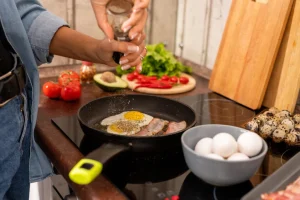Updated on March 12, 2023
Tips You Need When Cooking With An Electric Stove
People love to gripe about electric stoves. Threads on Reddit and Food52 are full with commenters kvetching about the alleged deficiencies of electric ranges. But are electrical cooktops really that bad? As according Consumer Reports, high-quality electric stoves beat their gas equivalents both for high-heat and low-heat application in the publication’s testing.
However, despite the fact that electric stoves are less harmful to the environment and better for cooking than gas stoves, they are not without their flaws. Cooking on an electric stove, especially if you’ve been accustomed to using gas, may be a major adjustment. In order to make your life simpler while cooking with an electric stove, we’ve put together this list of suggestions.

Move the pan on and off the burner to manage heat
Faster temperature changes are one of the most noticeable distinctions between gas and electric burners. When you realize anything is ready to boil over or burn, you may quickly lower the temperature of a gas burner to prevent it from happening. As soon as you turn off the heat source, the flame quickly dies down, and any remaining residual heat is quickly dissipated since there is some airspace between both the pot and the heat source.
When you lower the temperature on an electric burner, nothing occurs at first. Even after you switch the burner off, the coils (or the glass top, depending on the type of stove you’re using) remain hot. This problem is aggravated by the fact that the excess heat generated by the burner is absorbed by your pan, which is in direct contact with it.
The two-burner approach helps to prevent burned eggs and a cooktop drenched in overcooked rice water. Wait for the burner to cool down by moving the pan to a burner that isn’t on, or keep the second burner prepared at a lower temperature. A gas stove’s near-instant heat loss may be replicated this way.
Heat naturally turns on and off throughout the cooking process
When using an electric stove, you may notice that it doesn’t always remain on. Instead, LG and GE stoves claim that the heating element cycles on and off periodically to maintain a consistent temperature. In order to prevent overheating, the burner will switch itself off from time to time, even while the temperature is at its highest level.
This implies that if you’re using an electric stove, you’ll need to pay careful attention to the temperature. There is no guarantee that it will be the same temperature after a few seconds. Most of the time, it isn’t a major concern, but it is something to keep in mind if you are making a particularly delicate cuisine. When cooking on an electric burner, a Reddit user suggested that “having a vessel that can hold gobs of heat and dish it out compensates nicely for the inadequacies of an electric cooktop,” thus heavy cookware could be a good idea.
Pay attention to the hot surface indicator
When a gas stove has been switched off, there is no longer a flame to indicate that it has been turned off. Electric stoves, on the other hand, make it more difficult to see. Even though the heating element isn’t glowing, it may still be switched on. Electric burners may also be hot enough to cause you even after they have been switched off for a long time, so be careful. You don’t want to burn yourselves on a hot stove by leaving a burner on by mistake.
Thereby, it is your ally if you see the hot surface indication light flashing. When the burner temperature dips below 150 degrees Fahrenheit, the indication lights on LG and GE stoves will stay on. That shouldn’t burn you if you only touch it for a second. You may have forgotten to switch the burner off completely if the hot surface warning light remains illuminated after you have finished cooking for an extended period of time..
Use pans with flat bottoms
When you’re cooking on an electric range, having a level cooking surface is even more critical than when you’re using a gas range. When boiling water in pots with crooked bottoms on an electric range, the pots trembled, according to a user on a Food52 forum.
An electric stove manufacturer has backed up the recommendation to use flat-bottomed pots. According to GE, the heating element will cycle on and off excessively if your pan does not make proper contact with the burner. Using flat pans on a glass cooktop is especially important since warped pots will not transfer heat effectively and might possibly harm your stove. In the kitchen, efficient heat conduction is critical to achieving your goals. If you have a set of inexpensive, thin, warped pans, they may be harming your ability to cook on an electric range.

